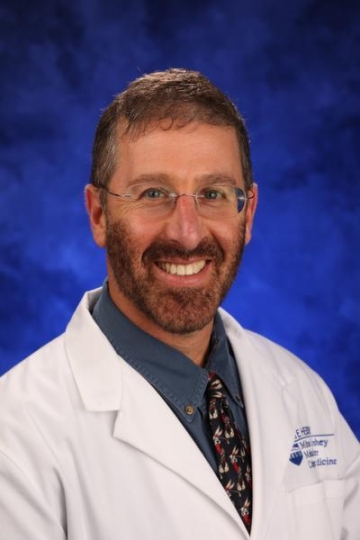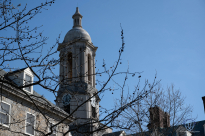Director outlines child abuse prevention efforts at new Hershey center
HERSHEY – The walls in Dr. Benjamin Levi’s office are covered with children’s drawings – reminders of all those he has helped. In August Levi, a professor of pediatrics and humanities at the Penn State Milton S. Hershey Medical Center, was named director of the new Center for the Protection of Children.
 Levi has studied child abuse across the world for more than a decade and specializes in the areas of reasonable suspicion and mandated reporting. He leads a team of more than 40 – from social workers to pediatricians to educators – with the goal of keeping children safe.
Levi has studied child abuse across the world for more than a decade and specializes in the areas of reasonable suspicion and mandated reporting. He leads a team of more than 40 – from social workers to pediatricians to educators – with the goal of keeping children safe.
Launched in December and initially funded with Penn State’s 2011 football bowl game revenue, the center supports the research, clinical treatment and prevention of child abuse, and promotes the education of mandated reporters.
For this story, originally published in the Centre Daily Times, reporter Carly Schaller sat down with Levi to learn more about him, the center and its future. Questions and answers have been edited for space reasons.
What sparked your interest in child abuse cases?
It was one particular case, a little over a decade ago. A child was brought in with an injury that could have been caused by abuse, but I wasn’t sure if I had “reasonable suspicion.” As a philosopher, I lost my understanding of common language years ago, so I tried to look up what “reasonable suspicion” meant in this case, and the more I looked the less I found. I began my work in studying child abuse by looking at how to answer that question. What is reasonable suspicion? And that’s been the majority of my work in the field – looking at and defining reasonable suspicion and mandated reporting.
Tell me about the center.
The center is a coordinated set of projects with a foundation of excellent clinical care in terms of assessing, diagnosing, treating and following up on children with injuries and issues caused by abuse.
... A lot of things might look like abuse but they’re not, and a lot of things don’t look like abuse that are. Being careful and systematic is the main focus of our endeavors as far as I’m concerned. And that begins with the clinical team. We then bring together researchers, social workers, educators, etc., to build off that clinical team.
The other part is education and advocacy. We want to use what we know about the issue to then go out and educate the public about how we can to a better job of protecting children.
You said the CPC consists of health care professionals, social workers, researchers and educators. How did all of these people get involved?
A lot of what I’ve been doing has been establishing these relationships and having these conversations with people. Some of these people have connections with Penn State – some are employees, faculty -- and some don’t. But I can’t tell you how many people have contacted me and said, “I’d like to help. If there’s a job, I’ll take it. If not, I’ll volunteer.” We would love to be able to share this program with everyone. The generosity of people in this area, and even nationally, has just been astounding to me.
Where is the funding coming from?
The initial funding came from the one-time allocation by the university – $1.2 million from the bowl game proceeds in 2011. We are actively searching for people who want to contribute in terms of resources, and we’ve have some people come forward – local and small, from grade schools to high schools. And others come from other resources. It’s heartening . . . People will start to be able to see the products of the center and hopefully that will encourage them to provide more resources to it.
Would you say awareness has increased since news of the Sandusky scandal broke last November?
It couldn’t have done anything but increase the national coverage of this issue. It just exploded. There was an outpouring of frustration. I think the frustration was not just directed at Penn State but also at the problem of this issue. The Sandusky case was not isolated to Penn State. Child abuse is a society-wide problem in every community across America. The fact that people weren’t angry about it two-and-a-half years ago is unfortunate. The fact that people are so passionate about it now is an opportunity to address this long-standing social issue.
What was your reaction to the scandal?
It’s interesting because I was halfway across the world, in Auckland, New Zealand, researching how they respond to child abuse when I first heard the news. I was devastated. It’s a tragedy. In a sense, the phenomenon of the sexual abuse wasn’t the news. To people who are familiar with the incidence of child abuse we know that this happens every day. We were as much aware of it on August 1, 2011, as we were December 1, 2011. A lot of people learned about the issue through the media attention. If one good thing came out of all that, it’s how much awareness has been raised.
The Children’s Hospital is set to open a new, 265,000-square-foot facility in January. Will the CPC be in that building?
. . . We hope to have our own space there. It will be exciting to have a physical space for our current staff. We’re recruiting at least two additional faculty members and another social worker.
What happens when a child is brought here and is suspected of being a victim of abuse?
Let’s say that an outside person – a teacher or physician maybe – sends a child over for an evaluation of suspected abuse. We have a pediatric social worker and a trained child abuse physician who examine the data – the child’s medical history, a physical and all the findings so far. Then they interview the family and evaluate the child. They perform all the tests that need to be done – blood tests, x-rays, whatever is appropriate. They pull all that information together, and based on their knowledge and expertise they give a professional assessment on whether abuse is likely or not.
If abuse is likely, they recommend treatment, and when the child is discharged they follow-up with either the family or foster care.
One of the things we’re building, if not several months from opening, is the outpatient clinic that will serve as a medical home for children who have been abused and then are placed in foster care. Sometimes when children are in foster care, they don’t receive proper medical treatments. Things can be missed. So one of our goals is to provide true continuity of care in a medical home for children. As that becomes a reality, we will then be following kids in foster homes to ensure that they get the care they deserve.
Before the CPC was launched, what was the medical center doing about child abuse?
It’s evolved in a lot of ways, but child abuse research has always been a priority here. We developed our “Look Out for Child Abuse” website two-and-a-half years ago and launched it six months before the Sandusky scandal. Two years ago, two of our physicians received specialized training in child abuse at the Children’s Hospital in Philadelphia. We recruited a certified child-abuse pediatrician six months before the scandal arose. For me, I’ve been doing research in this field for over a decade. . .
What happened in November 2011 catalyzed a lot of things. It ignited a reaction of ingredients that were already there and it provided fuel for developing things that many of us have been working on for a long time. It provided attention and resources, and it has helped raise this issue in terms of its priority.
The CPC has been under the radar for almost a year now. Why? How do people know to bring children here?
We’re trying to make sure that everything is in order. As we develop our clinical services -- you know, cross our t’s and dot our i’s -- people will know more about us. We want everything to function smoothly. We’re trying to roll out things when we have them ready. My role is to build and organize.
In terms of publicity, we want our work to speak for itself. We provide services that the people in the field know are valuable. They refer their patients and tell people, “If you want good care, the Center for the Protection of Children is where you go.”
I Googled “child abuse centers” last night and got over 9 million results. What is going to make the CPC unique and outstanding? Why will people want to bring children here?
We can provide great medical care and research, but there are a lot of excellent centers around the world that can do that. I think what we can do that I have not seen done extensively anywhere else is promote the education of mandated reporters. We can help them not just understand their responsibilities but also become motivated to carry out those responsibilities responsibly, not just in a knee-jerk kind of way.
Who are mandated reporters?
Lots of folks! Anyone who works in contact with children. Teachers, police officers, hairdressers, daycare providers, firefighters, social workers, any health care professional, a lot of different people.
One of our first projects is an online program to develop a training module specifically for school personnel. Recent legislation requires all school personnel to have a certain amount of training in child abuse. If that is successful, we have hopes of expanding that in other populations of mandated reporters.
What’s your favorite part of working with children every day?
The answer is in the question – I get to work with kids. If I come into work and I’m not in a good mood, within two patients I’m in a great mood. Kids are great.







